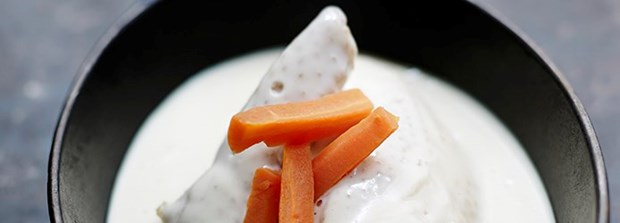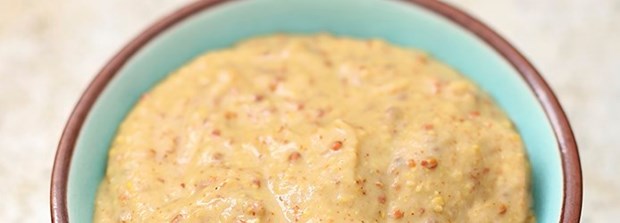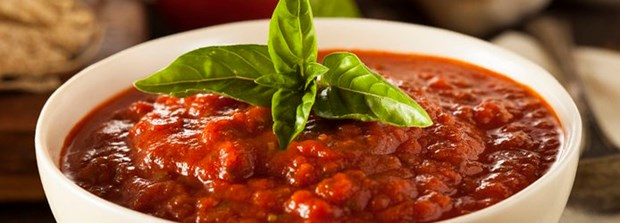The so-called "daughter sauces" are derivations from the five mother sauces, prepared by simply adding an ingredient or two to the core recipe: here's a list.
Having
already covered the so-called "mother sauces" of French cuisine, we
can move on to the daughter sauces – those derivations from the five mother
sauces that can alter and launch them in myriad directions by simply adding an
ingredient or two to the core recipe.
But
first, a reminder: mother sauces are basic building blocks from which many
other sauces can be derived. The original list of four was expanded to five –
béchamel, espagnole, velouté, sauce tomate, and hollandaise – in 1903 by Auguste
Escoffier, whose Le Guide Culinaire is the go-to Bible for academically-trained
chefs the world over.
Today,
we’ll take a look at some of the variations on this theme. There are dozens of
“daughter” sauces made with a base of the mother sauce and then adding to it.
But let’s take a look at at least two daughters from each mother, to get to
know the “extended family.”
Daughter sauces from Velouté
Base:
chicken or fish stock + flour + butter
“Velvet”
sauce starts, as so many French recipes do, with a roux (flour and butter), and
then boils the flavour of bones into it. But that’s just the start. There is a
good dozen daughter sauces, ranging from simple to more elaborate. Bercy sauce
adds white wine, lemon juice, parsley and sautéed shallots to the fish-based
velouté. Ravigote sauce can be warm or cold: warm, add Dijon mustard; cold, add
a vinaigrette.

Daughter Sauces | Supreme
One
of the most elegant daughter sauces is the Supreme sauce (picture above), to
which reduced chicken stock and crème fraiche is added to velouté, perhaps with
a touch of lemon. Normandy sauce enriches fish velouté with egg yolk, butter,
fish stock and cream – a great addition to steamed mussels.
Daughter sauces from
Bechamel
Base:
flour + butter + milk
It’s
hard to imagine anything that would qualify as a sauce with fewer components
than this, but your standard béchamel is just the starting point. It’s also not
as easy to make as it sounds, because the flour can clump and you’ve got to be
careful at what temperature you stir this in a saucepan, because if it’s too
hot the milk can curdle.
But
with your base, you can add crayfish butter and tails, and a bit of cream to
make Nantua sauce, which goes beautifully on pasta or with fish quenelles.
Soubise sauce simply adds pureed onions to the béchamel. This was originally a
sauce thickened by cooking onions slowly over a low heat with rice (the starch
leeching out of the rice was the thickener), but at academies these days onions
are cooked in beef broth and butter and added to the béchamel mix.

Daughter Sauces | Mustard
Philippe,
the 16th century Duke of Mornay, lends his name to Mornay sauce, which is
béchamel mixed with Gruyere cheese. But this is something of a misnomer,
because béchamel sauce, in the sense we think of it today, had not yet been
invented in the 16th century. It’s likely that Gruyere added to veloute sauce
was the original condiment on the duke’s table. And, as the name suggests,
mustard sauce simply adds the heat and bite of mustard to the béchamel base.
Daughter sauces from
Espagnole
Base:
veal stock + flour + browned bones + beef or veal + vegetables
The
most-involved to make of the mother sauces is the meatiest and its derivatives
number in the dozens (if not hundreds, if you take into account modern
variations). The best-known is surely Bourguignonne sauce, the heart of Boeuf
Bourguignonne, which fires up the mother sauce with red wine and shallot and
the handy flavour bomb of bouquet garni (bay leaves, thyme and parsley in a
cheesecloth, to make them easy to remove).

Daughter Sauces | Bourguignonne
Chasseur
sauce (hunter sauce), ideal over game meat, kicks it up with mushrooms and
shallots (is there anything that sautéed onions or shallots don’t improve?)
Legend has it that this sauce was invented by the same Philippe de Mornay, of
Mornay sauce fame – he’s also credited with Lyon Sauce and Porto Sauce. African
sauce adds pizzazz with an assortment of African or Creole seasonings.
Daughter sauces from
Sauce Tomate
Base:
fresh tomatoes + salted pork belly + onions + sugar + garlic + thyme
Though
“tomato sauce” sounds like it should consist of, well, tomatoes, it has the
most ingredients of any of the mothers, if you follow Escoffier’s recipe. The
daughter sauces are likely to be familiar to anyone who enjoys southern Italian
food, even without any chef training. Bolognese sauce adds browned minced meat
and sofrito (diced carrots, celery and onions, which is good in just about
anything).

Daughter Sauces | Tomato Sauce
Marinara
sauce (pictured above) just adds parsley, garlic and oregano. And while
Escoffier would not have known what to make of it, even sauces like tikka
masala might be considered a daughter of sauce tomate, with Indian spices
(ginger, turmeric, cayenne, cinnamon, paprika) turning a French base into a
subcontinental delight.
Daughter sauces from
Hollandaise
Base:
egg yolks + butter + lemon juice
Hollandaise
is the mother of mayo, which is the one sauce I can put on anything. Bavaroise
sauce adds horseradish, thyme and cream. Crème Fleurette sauce jazzes things up
with crème fraiche. Maltese sauce has orange zest and blood orange juice.
Noisette sauce throws in browned butter to the hollandaise. Bearnaise sauce
includes vinegar, shallots, tarragon and chervil. Choron sauce is Bearnaise
minus tarragon and chervil, but with added pureed tomato.

Daughter Sauces | Bearnaise
Paloise
sauce is Bearnaise minus tarragon, but with mint. Colbert sauce (as a fan of
Stephen Colbert, this may be my favourite) is Bearnaise with added white wine
reduction. We might consider Bearnaise a daughter with daughters of its own, a
sort of sub-mother sauce… but perhaps it’s easier to just refer to Paloise,
Colbert and Choron as “granddaughter sauces?”
By FDL